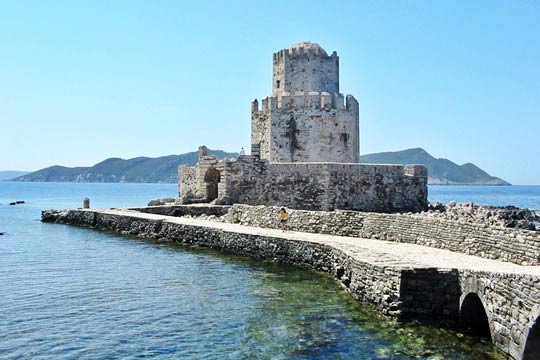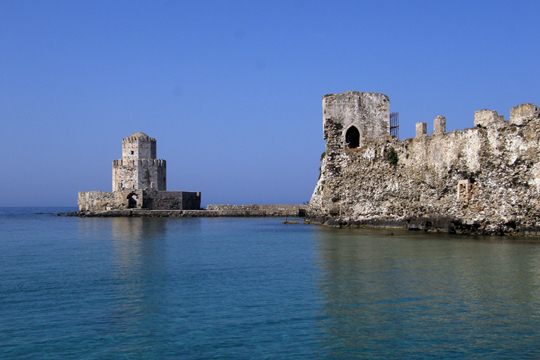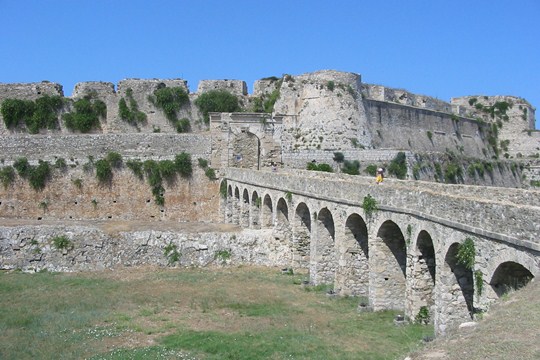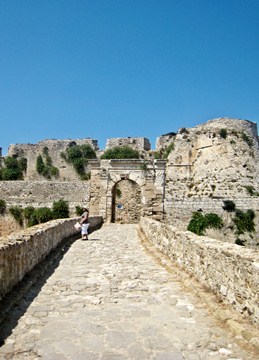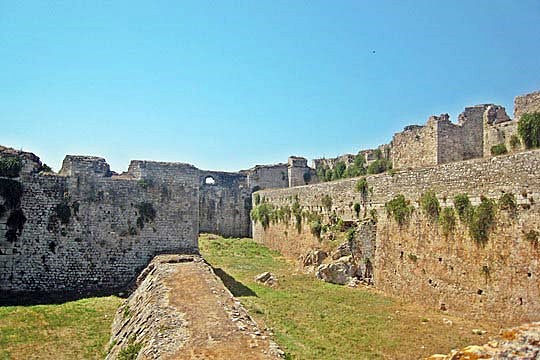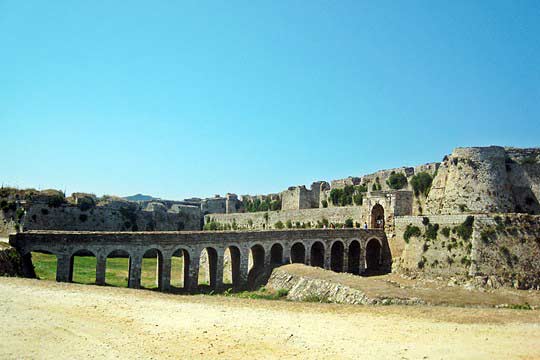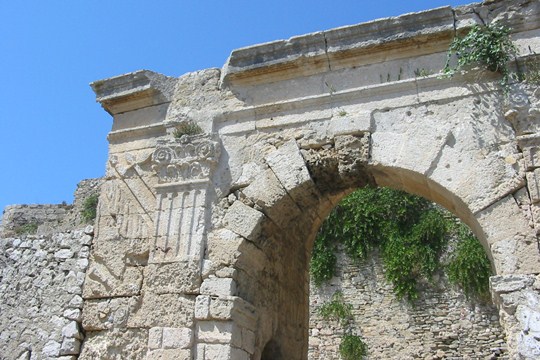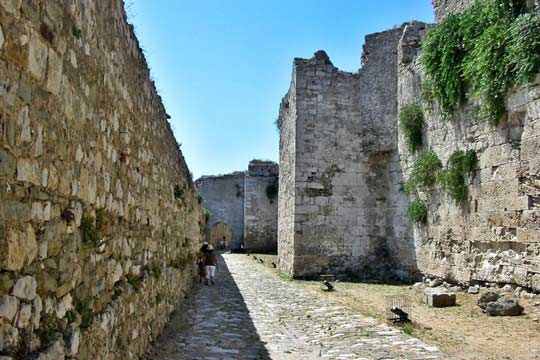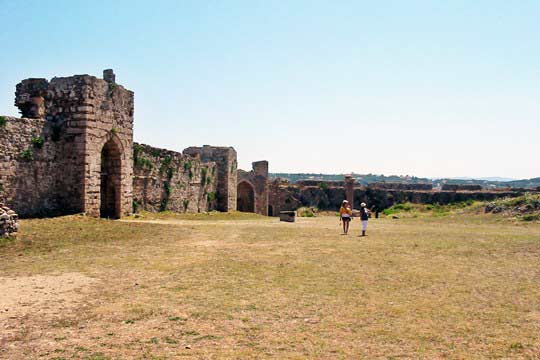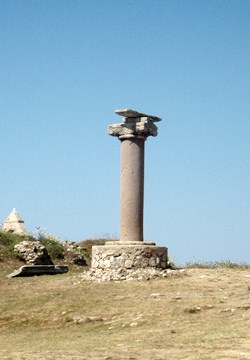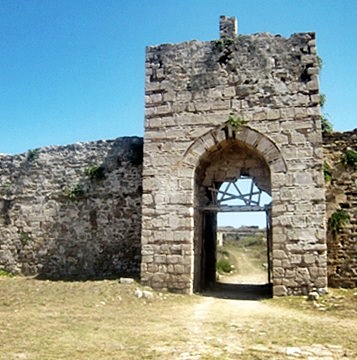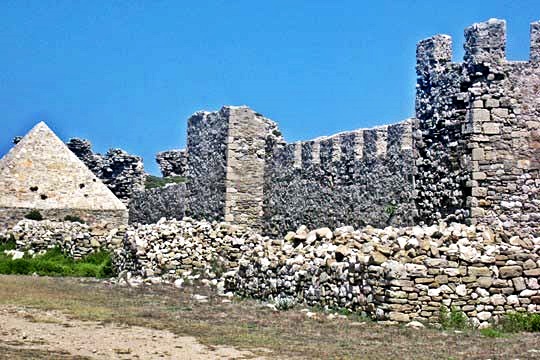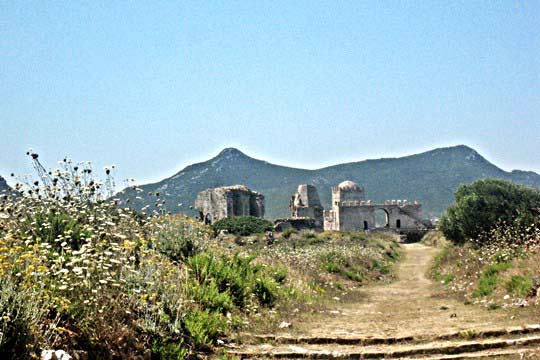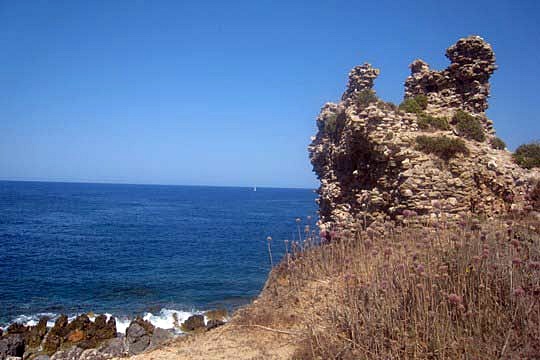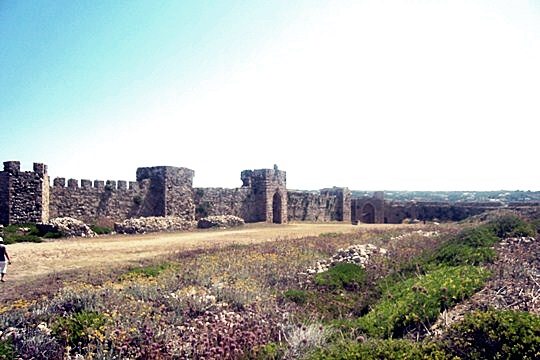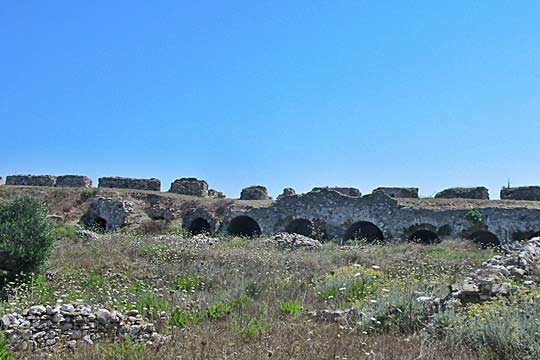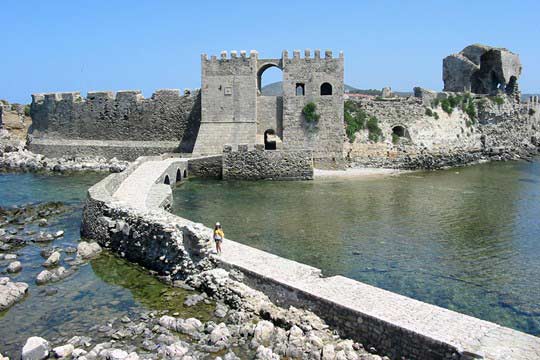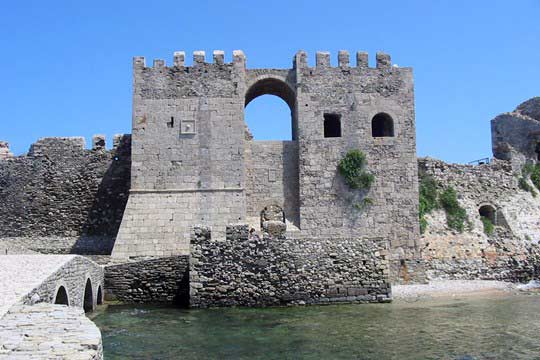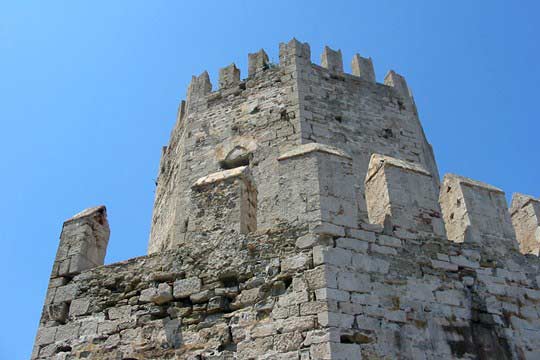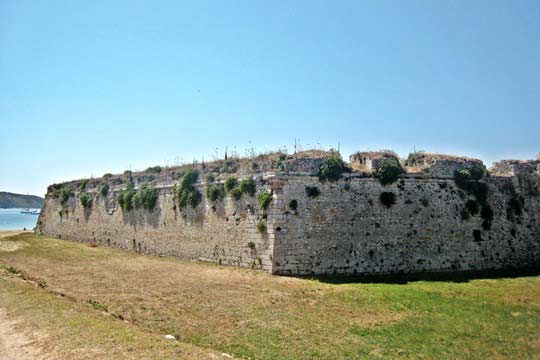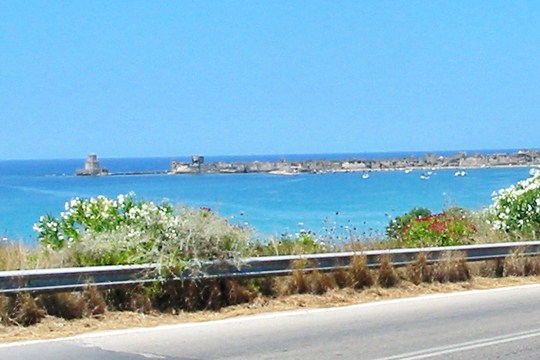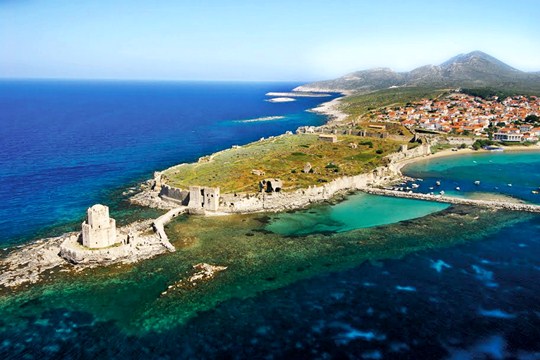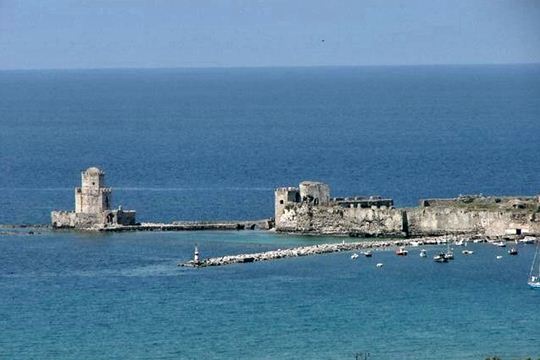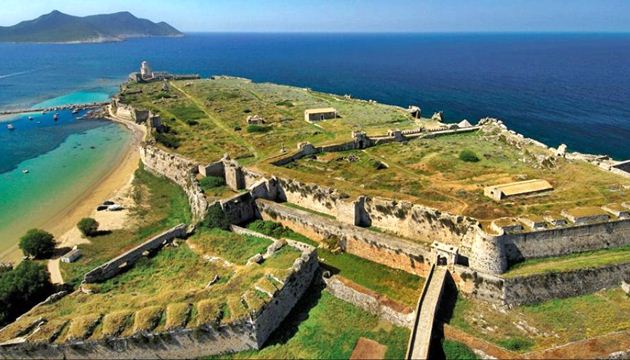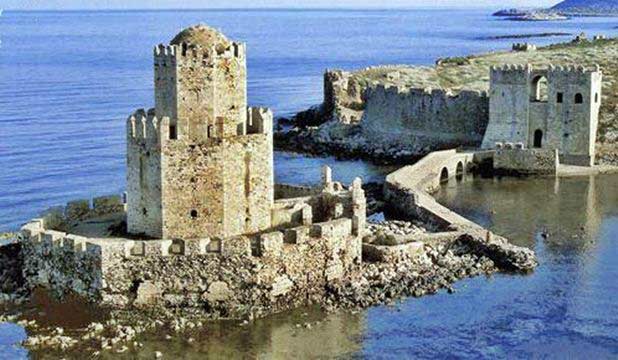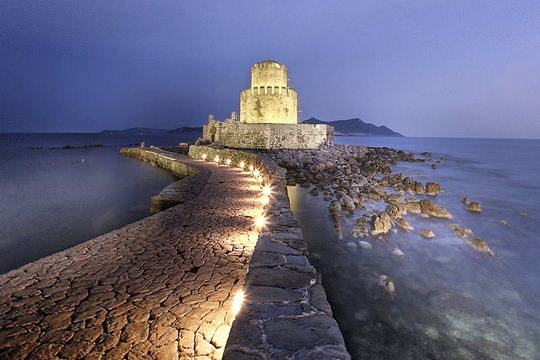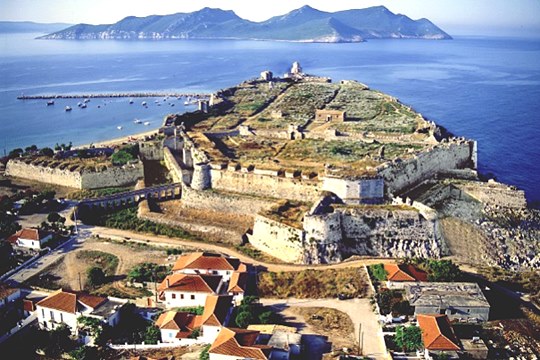Methoni, Pylos - Nestor, Messenia,Peloponnese
Methoni Castle
| Location: |
| Methoni, SW Peloponnese |
| Region > Prefecture: | 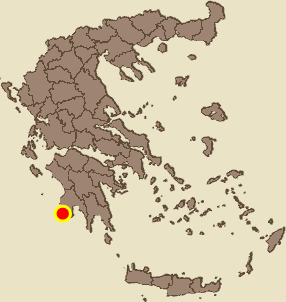 |
| Peloponnese Messenia | |
| Municipality > Town: | |
| City of Pylos - Nestor • Methoni | |
| Altitude: | |
| Zero Altitude |
| Time of Construction | Origin | |
| after 1209 | VENETIAN |
|
| Castle Type | Condition | |
| Fortress-state |
Relatively Good
|
The castle of Methoni -actually a fortified city- is one of the most important and the most beautiful castles in Greece. It was built by the Venetians after 1209 at a strategic location, on a rock penetrating the sea and is separated from the land by an artificial moat.
Nowadays the fortress, even though in ruins, continue to be impressive. The castle of Methoni occupies the whole area of the cape and the southwestern coast to the small islet that has also been fortified with an octagonal tower and is protected by the sea on its three sides. Its north part, the one that looks to land, is covered by a heavily fortified acropolis.
History
In the small peninsula in the SE end of Peloponnese there has always been a city since the ancient times, renown for its harbour. It has been identified to the city Pedasus that Homer mentions as the last of the seven cities that Agamemnon offers Achilles in order to subdue his rage. Pausanias names the city “Mothoni” and mentions that it was named after either the daughter of Oineas or after the small fortified islet, the name of which was “Mothon Lithos”.
During the 4th century B.C. Methoni was fortified with more elaborately and remained autonomous until the imperial roman years, when it enjoyed the favour of some emperors. During the Byzantine years, it was still an important harbour and one of the major cities of the Peloponnese, and the seat of a bishop.
The Byzantine commander Belisarius used it as a base to attack the Vandals of North Africa in the 6th century, and there is reference to a Byzantine port here in 583.
The Venetians started having their eye on the harbour of Methoni since the 12th century, since 'it was in the middle of the route from Venice to the East'. Moreover, in 1125, they had launched an attack against the pirates who used it as a shelter, because they had captured Venetian traders on their way home from the East.
When the Franks had Constantinople under a siege in 1204, Geoffrey de Villehardouin strayed with his ship to Methoni on his way to Constantinople and had to spend winter in the area. He then accepted the invitation of the local lord Ioannis Kantakouzinos to help him occupy the Western Peloponnese. The cooperation was successful. When Kantakouzinos died, his son tried to break the alliance, with no success, since Villehardouin had understood that the conquering of the Peloponnese by the Latins would be easy.
In 1206, however, the Venetians occupied Methoni and their domination was established in the spring of 1209 with a treaty signed with Villehardouin, who made all the necessary consents that would guarantee him the help of Venice for the final subordination of the Peloponnese. The Venetians fortified Methoni, which developed, as well as Koroni, into an important trade center with great prosperity.
It was only natural to attract the attention of the Turks, who, despite the treaties with Venice, were harbouring the notion of conquering the area. Vaghiazit II, in late 1500, gathered his forces against Methoni, the important middle station between Venice and the Holy Lands, where every traveler stopped on their way to the East.
Sultan Vaghazit, despite the hard siege, would not have been able to invade it if the inhabitants, thrilled by the arrival of reinforcements, had not deserted the walls, a fact that the yenitsars took advantage of and invaded the tower from the governor´s palace. The city was given to the flames, the Catholic bishop was killed while talking to the people, the men were decapitated, the women and children were sold to slavery. On the 9th of August 1500, Methoni fell after having been in the hands of the Venetians for about three hundred years. Happy for his trophy, Vagiazit made the yenitsar who first climbed the walls a santakbei, meaning a provincial commander and on the first Friday after the invasion, when the fire went out, he went to the desecrated cathedral to offer his thanks to the god of battle, to whom, as he confessed, when he was looking into the deep moat, owed the conquering of this fortified city. The desolation was so complete that he ordered families to be sent “from every village of Moreas ” so that Methoni regains its population again.
The walls were repaired and the period of the first Turkish occupation began. In 1531 the Knights of St John landed on the port of Methoni, planning to occupy the previously Venetian colony. Initially, they managed with a conspiracy to disembark and take out the guards. But the occupation of the fortress was not completed because Turkish reinforcements arrived that forced them to leave, after having ran shacked the town and arrested 1600 prisoners. In 1572 the shores of Methoni were threatened by Don Juan of Austria, who did not manage to take it.
During the whole of the 16th and 17th century, even though the look of Methoni has not changed, the decline in all sectors was obvious. In June 1686 the forces of Morozini had Methoni under siege. The Turks surrendered on the 10th of July. The walls, that suffered substantial damages during the siege were repaired and new inhabitants were sent to reinforce the population of the town. However, this second period of Venetian occupation did not last for long. In 1715 the Turks launched a siege to the castle and the Venetian defenders, deserted it. During this second period of Turkish occupation, the decline was complete. As is apparent from travelers´ descriptions, the population was reduced, the battlements were in bad condition and the harbour became shallow. The most important trade conducted was that of slaves!
During the first years of the Greek Revolution (1821), Methoni was one of the few castles that was not taken by the Greeks.
In 1825, the forces of the Egyptian Ibrahim pasha landed in Methoni (invited by the Turks to fight the Greeks). The headquarters of Ibrahim was the command building of Methoni, above the entrance of the castle. In the same building, the French general Maison who freed the town together with others in the Peloponnese, settled in 1829.
Structure, Fortification & Buildings
The castle of Methoni occupies the whole area of the cape and the south-western coast to the small islet that has also been fortified with an octagonal tower and is protected by the sea on its three sides. Its north part, the one that looks to land, is covered by a heavily fortified acropolis. A deep moat separates the castle from the land and communication was achieved by a wooden bridge. The Venetians built on the ancient battlements and added on and repaired it during both periods that they occupied the castle.
Its entrance is in the middle of the north side and is accessed by a stone bridge of 14 arches, that was built over the moat by the French engineers that accompanied general Maison in 1829. The entrance gate ends in a curviform arch framed on the right and left by pilasters with Corinthian capitals. It is considered to be the work of Venetians after 1700. On the right and left of the entrance, two large battlements can be seen. On the east part is the one built by general Antonio Loredan, during the second period of Venetian occupation.
That is when the moat that surrounded the battlements was expanded towards the land and work was done on the bank of soil, that bears a plaque with a relief of the Lion of St. Mark. On the west edge is the Bembo battlement, which was built during the 15th century, The north side of the walls had reached its final form in the beginning of the 18th century and it retains it to this day. The north part of the walls reach 11 meters in height and the two battlements communicated through a passage.
The wall is fortified with square towers on the NE side and a large round one on the NW. In order to build that, they used well worked stones that were lined with mortar. In some parts they used ancient construction material, easily seen nowadays in one of the north side towers as well as on the south part of the walls.
Right after the central gate, a domed road opens up that leads through a second gate and then a third in the interior of the castle, where the habitable part was and which was separated from the north part with a vertical low wall (approximately 6 meters), fortified with five towers (four square and one octagonal) is dated to the period after 1500, when the Turks tried to reinforce the population and the fortification of the caste.
In the interior there are ruins of the houses where the Venetian lords lived during the period of rise, the paved street that led to the sea gate, the ruins of a Turkish bath , the Byzantine church of St. Sophia, close to which a slate with Latin lettering was found (dating back to 1714), parts of Doric pillars, a monolithic granite pillar (1493/4), unlined, with a capital on the top of Byzantine style, which is supposed to have supported either the winged Lion of Venice or the bust of Morozini. That is why it is called “Morozini´s stele”. There was an inscription on the capital that has not survived to this day.
On the left of the entrance are the ruins of the building which originally Ibrahim pasha used as a residence in 1825 and later general Maison. The French of the liberating corps remained in the area till 1833 and the construction of the church of Santa Sotira, which is still in the castle is attributed to them. In the interior of the castle there are also a few cisterns and the remains of the British prisoner´s cemetery during the 2nd World War.
On the south part of the walls rises the spectacular sea gate which has recently been restored. It is comprised of two tall square towers (16 meters) that are linked with a platform (about 18 meters long and 6 wide) that is crowned with bastions. The gate opens in the center and it ends up in an arch on the top. The towers are built with large porous stones and had rooms in their interior. A stone-paved stretch leads over a small bridge to the small fortified islet of Bourtzi. This is the place where many soldiers and inhabitants of Methoni were slaughtered, when the Turks occupied the fort in 1500.
Bourtzi is dated back to the period after 1500 and has been used in various instances as a prison. It has a two-floor octagonal tower. On each floor there is a parapet with bastions. The tower finishes in a round dome. On the lower floor there was a cistern and the whole works, with small defensive value, is dated in the first period that the Turks occupied the fortress.
The west part of the walls is not as well constructed as the others. The wall was fortified with 5 square towers and chronologically it dates to the first period, when the Venetians occupied the fortress. This part with the rocks and the rough sea makes it hard to attack the castle and this is probably why there was not much attention paid to its construction. Moreover, this part of the castle seems to have suffered less damages as well as less repairs. It was here that during the 2nd World War, after an explosion, parts of well constructed stones from the ancient walls of Methoni were found. Ancient constructing material has also been used in the foundations of one of the square towers. In the interior of the walls, ruins of Turkish military establishments are preserved.
The east side of the walls also reached initially to the sea. Nowadays, a long strand of beach lies in front of a large part of it. Parallel to the east wall, up to the Bourtzi, there was a pier and this is where the small fortified harbour was formed (mandrachio), while the big one was to the northeast where ships could be pulled. The wall was fortified with towers on this side as well. The long east side has suffered many repairs, performed on the initial venetian battlements of the 13th century, mainly during the second venetian occupation and the Turkish occupation. In one of the towers parts of the byzantine fortification are preserved. On the east side there was a small gate protected by a tower. On the southeastern side, the ruins of a Turkish tower are preserved.
On various parts of the fortification there are venetian emblems with the winged lion of St. Mark and inscriptions. This is the case on the north part of the Loredan battlement, where there is an inscribed plaque from the time when general Loredan was in command in the Peloponnese. On the north wall, on the right of the main entrance, there is also a plaque with the coat of arms of the families of the Foscarini, Foscolo and Bembo, to which the inscription denotes the construction of the Bembo battlement, just before 1500.
| First entry in Kastrologos: | July 2012 | Last update of info and text: | December 2018 | Last addition of photo/video: | January 2024 |
Sources
- Video by the user haanity titled Μεθώνη | Methoni drone Dji Phantom 3
- webpage ΟΔΥΣΣΕΥΣ - Greek Ministry of Culture Κάστρο Μεθώνης Συντάκτης Ιωάννα Αγγελοπούλου, αρχαιολόγος
- blog e-Epiloges -Κάστρο Μεθώνης , Ιωάννα Αγγελοπούλου, αρχαιολόγος
- Video by the user G Traveller Κάστρο Μεθώνης | Methoni Castle (January 2024)
|
|
| Access |
|---|
| Approach to the monument: |
| Easy access from the town of Methoni located 61km southwest of Kalamata. |
| Entrance: |
| Ticket entrance. Limited hours. |
| Other castles around |
|---|
| Bourtzi of Ampelokipi |
| Vigla at Finikounda |
| Grizi castle |
| Castle of Iklaina |
| Castle of Cosmina |
| Niokastro |
| Palaiokastro |
| Tower at Limni Papa |
| Fort of Pera |
| Castle of Velika |



